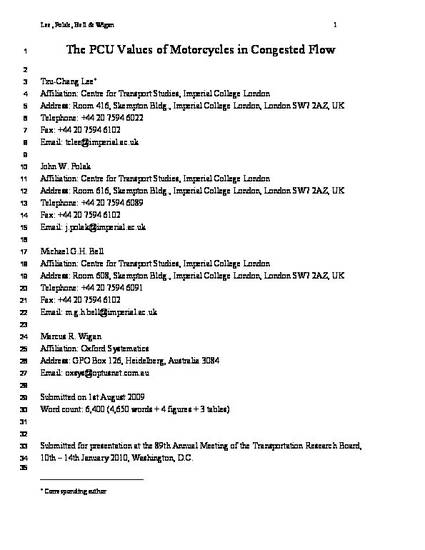
Unpublished Paper
The PCU Values of Motorcycles in congested flow
Transportation Research Board 89th Annual General Meeting
(2010)
Abstract
The flow rate of a traffic stream is a variable of interest to transport engineers. It is usually expressed in terms of vehicles per lane per hour. In mixed traffic, different vehicle types cause different disturbances to the traffic. Expressing the flow rate by merely using vehicle counts could cause errors. Hence, the flow rate is usually converted to the volume of an equivalent passenger car flow. Such index is known as PCU (Passenger Car Unit) or PCE (Passenger Car Equivalent). The PCU value of a passenger car is set to be 1.0. Basically each vehicle type is assigned a single PCU equivalent to represent its relative disturbance to the flow under the prevailing traffic condition. However, the PCU equivalent of a vehicle could vary depending on various factors such as the movements at intersections, the flow conditions, the frequency of lane-changing movements, the ability to move between formal lanes, the layout of the section of the road system, etc. Thus, a set of PCUs might be assigned to a vehicle type to describe the effects of some specific factors. There are currently a wide range of PCUs for motorcycles found in the literature. This implies that the PCU for motorcycles could vary with the traffic conditions. However, without a systematic analysis, such a wide range of PCUs from different sources not only causes confusion, but could cause significant errors when estimating the capacity of roadways, especially for those areas having large number of motorcycles. To have a better understanding of the PCUs for motorcycles under various traffic conditions is thus undoubtedly critical. Methods for estimating PCUs can largely be divided into two groups: the headway ratio methods and the flow rate methods. The former group calculates PCUs by measuring the differences of headways between vehicle types. It can be applied to the mixed traffic in which vehicles follow lane discipline strictly. However, it is not suitable for measuring the PCUs of single-track two-wheelers such as bicycles and motorcycles. These single-track two-wheelers, particularly motorcycles, have been observed having some idiosyncratic behaviour patterns, e.g., (1) rather than the conventional lane-based progression. The headway ratio method cannot estimate their PCUs precisely when the ordinary lane-based movement is expanded to other manoeuvres, such as filtering, moving alongside other vehicles in the same lane, oblique following, swerving, maintain shorter safety distances when aligning to the edge of preceding vehicles (2). Besides, these behaviour patterns could affect the PCUs significantly. Under these circumstances, the flow rate methods are suitable to measure the PCUs of motorcycles. This type of methods calculates PCU values using the difference of the flow rates caused by the presence of a certain vehicle type. As all the disturbances caused by motorcycles’ non-lane-based steering behaviour patterns will finally reflect on the flow rates, the impact of motorcycles is captured and converted to PCU equivalents. The estimation of PCUs for motorcycles is usually complex as the PCUs could vary with the contexts of urban networks. Motorcycles have flexibility and freedom to maintain higher speeds than do passenger cars in congested areas due to their advantages of narrow widths, small sizes, high power-to-weight ratios and intuitive steering methods (2). Thus, their PCU equivalent in congested conditions would reasonably be expected be lower than that under free flow conditions. In addition, some of the non-lane-based movements may have a flow effect and others none. As the disturbances that they cause to the traffic vary with the traffic environments, a systematic investigation of their PCUs under different scenarios is necessary. However, it is difficult to conduct such an investigation in the real world as many conditioning variables would have to be carefully controlled.To reduce this complexity to a manageable form, a computer simulation model capable of imitating the characteristic behaviour patterns of motorcycles and their interaction to different surrounding environments would be an ideal tool for such a task. This paper presents a systematic analysis of motorcycles’ PCU values in different traffic conditions by using a simulator capable of describing the characteristic behaviour patterns of motorcycles (3). This simulator is able to investigate how motorcycles utilise various forms of road space based on different driving conditions. Variables related to PCUs such as the number of lanes, the width of lanes, the proportion of motorcycles and the congestion level are manipulated. Thus, the PCU values of motorcycles in different traffic environments can be calculated. This paper is organised as follows: Section 2 reviews the PCU values of motorcycles measured in other studies as well as the methods for measuring PCU values. Section 3 describes the methodology. Section 4 presents the simulation results and Section 5 draws several conclusions for this paper and points out the possible directions for future work.
Keywords
- motorycle,
- PCU,
- roadspace,
- capacity,
- traffic,
- simulation
Disciplines
Publication Date
Winter January 15, 2010
Comments
Paper 10-2819, presented at the 89th TRB in Washington DC and published on the 89th TRB CDRom
Citation Information
Tzu-Chang, L, Polak, J, Bell, M.G.H, Wigan, M.R. (2010) The PCU Values of Motorcycles in congested flow. Paper 10-2819. TRB 89th CDRom. Washington DC. 17pp
Creative Commons License

This work is licensed under a Creative Commons CC_BY International License.
